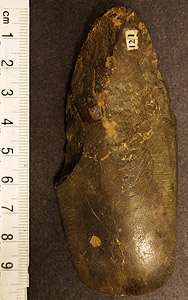Neolithic Yorkshire – polished axes

Polished Neolithic axe: Hare Hill, Thornton Moor, N. Yorks. (Early Neolithic 3957-3797 BC)
One of the most characteristic artefacts of the Neolithic period is the stone axe. In fact it was such a prolific and efficient tool that many scholars agree that it was responsible for much of the extensive forest clearance at this time, marking the beginning of a more open agricultural landscape which in one shape or another continues to this day. Given its extraordinary economic power in transforming the landscape and with it shaping and supporting life in the Neolithic, it is not surprising that the stone axe was revered and endowed with special status, as many highly polished stone axes of quite remarkable beauty have been found which were clearly never intended to be used as practical axes, but as decorative or ritual objects.